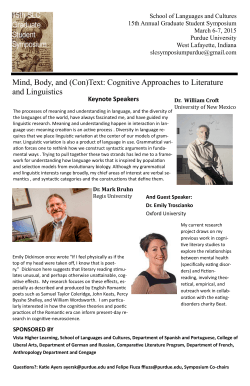
TH special issue Neuroergonomics
Presses Universitaires de France Prof. Françoise Darses Directrice Exécutive du Travail Humain / Executive Editor e-mail : francoise.darses@irba.fr APPEL À COMMUNICATIONS Numéro Spécial CALL FOR PAPERS Special Issue Le travail humain The journal LE TRAVAIL HUMAIN invite authors to participate in a Special Issue “Neuroergonomics: measuring the human operator’s brain in ecological settings” Guest Editors : Frédéric Dehais, Mickaël Causse, and Julien Cegarra This special issue will be dedicated to Dr. Raja Parasuraman, a pioneer and leader of Neuroergonomics Human Factors and Ergonomics have continuously evolved in their approach and practice during the 20th century. The spectacular recent advances in cognitive neuroscience have radically expanded our knowledge on human cognitive functioning. Since the early 2000’s, Neuroergonomics, the intersection of Neuroscience, Cognitive Engineering and Ergonomics, proposes to examine the brain mechanisms and underlying human-technology interaction in increasingly naturalistic settings representative of work. This innovative approach promotes the use of portable devices, such as functional near infrared spectroscopy (fNIRS), electroencephalography (EEG), eye tracking and other psychophysiological measurements that offers promising prospects for investigating the neural correlates of mental workload, perception, human error and human computer interaction. Objective - The aim of this special issue is to bring together research illustrating the mechanisms underlying expertise and cognitive functioning in human operators. Priority will be given to research that analyzes the brain at work in ecological environments and facing complex task constraints. Topics - This special issue seeks original, highquality papers in all areas related, but not necessarily restricted to: ! Innovative methodologies and protocols using brain imaging techniques and eye tracking in realistic operational settings; ! Future ergonomics applications, usability, ! ! ! ! and ethical issues related to Brain Computer Interfaces (BCI) and human performance monitoring; Adaptive user interfaces and cognitive countermeasures to enhance performance and mitigate human error; New interactive concepts such as mixed initiative for more efficient human-system interaction; Applications of Virtual Reality and serious games (e.g., work environment supervision, operator training); Learning and skill acquisition in operators. All papers should present a contribution to the design of safer and more efficient work environment and technologies. Authors are kindly asked to inform us as soon as possible if they intend to submit an article by sending a letter of intent (any format, 250 words minimum) by e-mail to F. Dehais, M. Causse (familyname@isae.fr) and J. Cegarra (julien.cegarra@univ-jfc.fr). Manuscripts must comply with the review submission format (see www.letravailhumain.org) except for their length which, for this special issue, must be between 16 and 20 pages. Les articles retenus seront publiés en anglais mais pourront être soumis en français. La version révisée sera produite en langue anglaise (traduction à charge des auteurs). Letter of intent (250 word min): as soon as possible Manuscript submission: 15th of November 2015 First notification: January, 30th, 2016 Revised version (English): April, 1srt 2016 Final decision : June, 2016 Publishing: January, 2017 (Vol. 80, Number 1)
© Copyright 2025





















